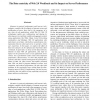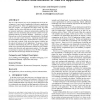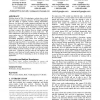ISPASS
2009
IEEE
14 years 4 months ago
2009
IEEE
Advances in network performance and browser technologies, coupled with the ubiquity of internet access and proliferation of users, have lead to the emergence of a new class of web...
SOSP
2007
ACM
14 years 6 months ago
2007
ACM
The rise of the software-as-a-service paradigm has led to the development of a new breed of sophisticated, interactive applications often called Web 2.0. While web applications ha...
ICWS
2009
IEEE
14 years 6 months ago
2009
IEEE
—The recent surge of popularity has established Mashups as an important category of Web 2.0 applications. Mashups are essentially Web services that are often created by end-users...
WWW
2008
ACM
14 years 10 months ago
2008
ACM
Online collaboration and sharing is the central theme of many webbased services that create the so-called Web 2.0 phenomena. Using the Internet as a computing platform, many Web 2...
WWW
2008
ACM
14 years 10 months ago
2008
ACM
The term "Web 2.0" is used to describe applications that distinguish themselves from previous generations of software by a number of principles. Existing work shows that...
WWW
2008
ACM
14 years 10 months ago
2008
ACM
Web 2.0 marks a new philosophy where user is the main actor and content producer: users write blogs and comments, they tag, link, and upload photos, pictures, videos, and podcasts...
WWW
2009
ACM
14 years 10 months ago
2009
ACM
With the advent of Web 2.0 technologies, websites have evolved from static pages to dynamic, interactive Web-based applications with the ability to replicate common desktop functi...
SIGSOFT
2008
ACM
14 years 10 months ago
2008
ACM
Modern Web 2.0 applications, such as GMail, Live Maps, Facebook and many others, use a combination of Dynamic HTML, JavaScript and other Web browser technologies commonly referred...



